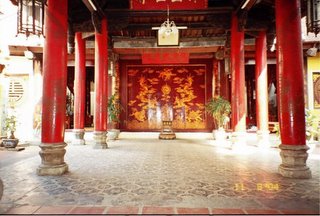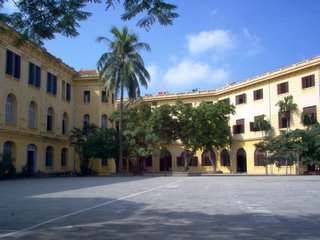VN Trip-Day4-Lonely Planet Hanoi Walking Tour
As I roamed through these narrow streets of the Old Quarters, I think of my mother. When she was young, my grandmother would send my mother out on errands and she would roams through these back streets. She is familiar with all these trees-lined streets.
My grandfather (mother-father) was postal worker. He had a post at a rubber plantation once. My mother was born in Kampuchia (now Cambodia). Back then it was part of Indochina. My grandfather was working in Saigon when the Geneva Accord was signed and went into affect. After that, my grandparents was not able to return to Hai Phong of North Vietnam.
The Old Quarters is known for their 36 streets, each named for the merchandise sold on that street. The guild streets were named for their products, service or location.
We started out at Ngoc Son Temple in the northern end of Hoan Kiem Lake. Headed north on Pho Hang Dau, we were soon surrounded by shoe shops selling every shape, size and style. The only thing that kept me from buying all those shoes was that I only had a single backpack to carry everything.
We crossed over to Pho Cau Go (meaning Wooden Bridge) to Pho Hang Be (bamboo rafts), continue north to the 'T' intersection with Pho Hang Bac (silversmiths). Near here are several shops, where artisians carve intricate gravestones by hand, bearing an image of the deceased. A short detour north on Pho Ma (sold sacred joss/votive papers) lead you to the Memorial House at number 87. We toured this Chinese merchant's home, recently restored and opened as a museum.

Returned to Pho Hang Bac (meaning silver) and head west, then right onto Pho Hang Ngang (Transversal Street), right again onto Pho Hang Buom (sails). We stopped at the Bach Ma Temple, with its red funeral palanquin. Legend has it that Ly King used the pagoda to pray for assistance in building the city walls because they persistently collapsed, no matter how many times he rebuilt them. His prayers were finally answered when a white horse appeared out of the temple and guided him to the site where he could safely build his walls. Evidence of his success is still visible at Cua O Quan Chuong, the quarter's Old East Gate at the eastern end of Pho Hang Chieu (mats), near the intersection with Pho Tran Nhat Duat.

We took a cab over to the striking neo-Gothic St. Joseph Cathedral, noteworthy for its square towers, elaborate altar and colourful stained-glass windows. It was built in 1886. The church was re-opened in 1992 when freedom to practice Catholicism was reinstated. We wandered around the back, where there is a school. My father went there when he was a kid. The school no longer belongs to the church. It is now owned by the government.
Later that day, we also went to the First University.

0 Comments:
Post a Comment
<< Home